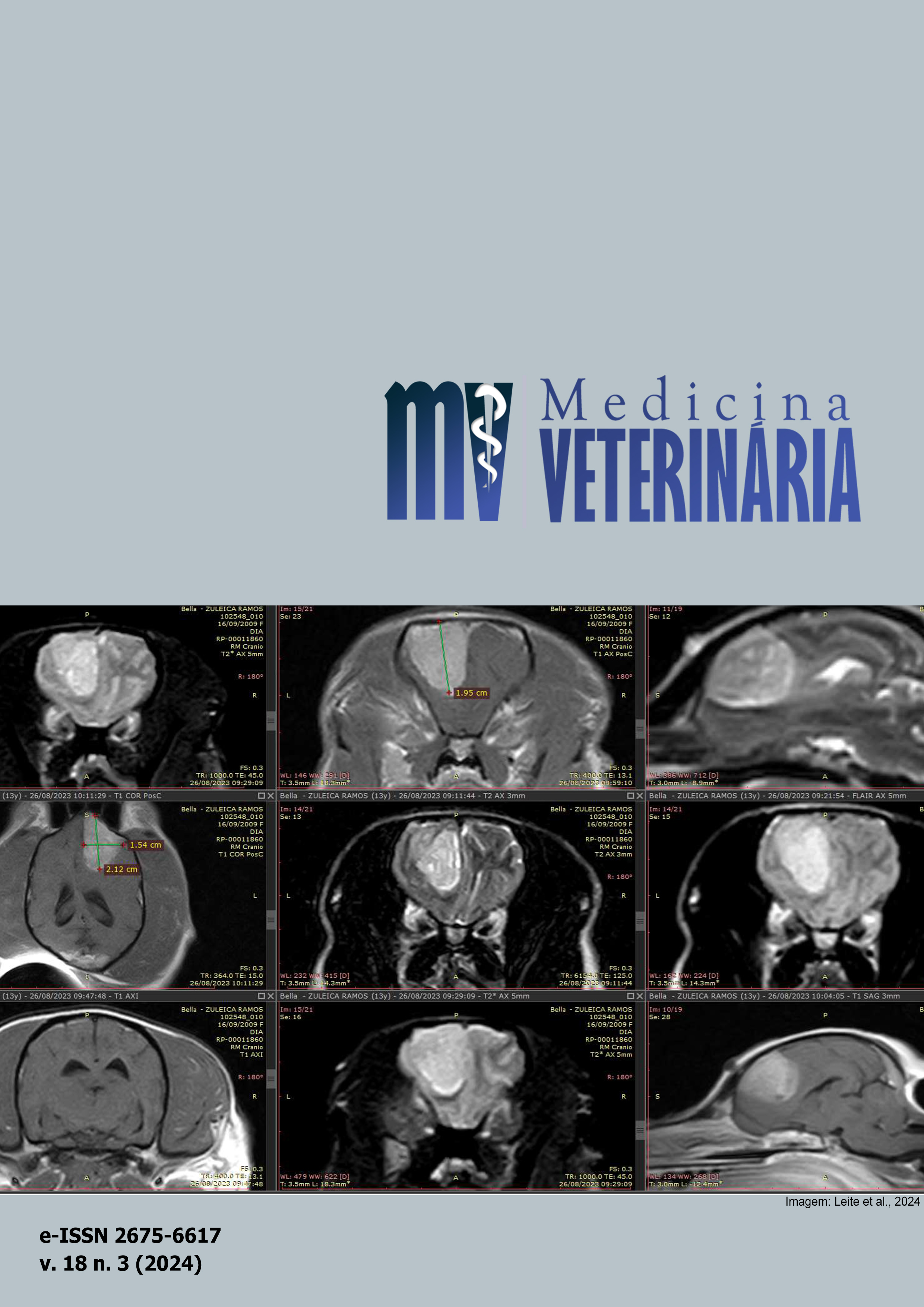Ácido Trans-ferúlico na maturação in vitro de zigotos ovinos
DOI:
https://doi.org/10.26605/medvet-v18n3-6502Palabras clave:
antioxidante, fecundação in vitro, maturação in vitro, ovelhaResumen
O objetivo desse trabalho foi avaliar o uso do ácido trans-ferúlico (ATF) na maturação in vitro de oócitos e na produção in vitro de embriões ovinos. Para isso, oócitos foram divididos em cinco grupos de tratamento: o grupo controle (CON), no qual oócitos foram imersos em meio sem utilização de antioxidantes, já no grupo cisteamina (CIS), os oócitos foram inclusos no mesmo meio do grupo CON, mas contendo 100µM de cisteamina como fonte antioxidante; nos grupos ATF10, ATF50 e ATF100, os oócitos foram inclusos no mesmo meio do grupo CON, mas contendo 10µM, 50µM e 100µM de ácido trans-ferúlico, respectivamente. A maturação in vitro (MIV) foi realizada por 24h, a 38,5°C, com 5% de dióxido de carbono (CO2). Em seguida, foi realizada a fecundação in vitro (FIV), seguido de cultivo in vitro (CIV) dos presumíveis zigotos, o qual ocorreu em meio fluido sintético de oviduto (SOF) com 2mg/mL de albumina sérica bovina (BSA), sendo avaliada a taxa de estruturas clivadas após 48h de cultivo. Os dados foram apresentados em porcentagem e foi utilizado o teste de Qui-quadrado no software Epi Info®. Os resultados foram considerados significativos quando p?0,05. Foi possível observar que em relação a taxa de expansão o AFT100 se mostrou superior ao ATF10, CIS e CON (95,3%; 76,7%; 79,1%; 81,4%). Para grau de expansão das células do cumulus, número de presumíveis zigotos e número de estruturas clivadas, não houve diferença significativa entre os grupos com ácido trans-ferúlico (ATF10, ATF50 e ATF100) e cisteamina (CIS). Sendo possível concluir que o ácido trans-ferúlico é uma alternativa à cisteamina como agente antioxidante no meio de maturação in vitro de oócitos ovinos.Descargas
Citas
Aghaz, F.H.; Hajarian, H.; Shabankareh, K.; Abdolmohammadi, A. Effect of sericin supplementation in maturation medium on cumulus cell expansion, oocyte nuclear maturation, and subsequent embryo development in Sanjabi ewes during the breeding season. Theriogenology, 84(9): 1631-1635, 2015.
Aureliano, E.K.D.O; Lima, A.M.C.; Santos, D.R.P.; Freitas, B.C.D.; Silva, J.D.M., Oliveira, L.K.P.; Lima, S.D.O.; Pereira, A.B.; Lopes, I.M.; Silva, B.M.; Cordeiro, M.F.; Lopes-Júnior, E.S. Efeito do mio-inositol na produção in vitro de embriões ovinos. Revista de Veterinária e Zootecnia, 30: 1-7, 2023.
Gorczyca, G.; Wartalski, K.; Romek, M.; Samiec, M.; Duda, M. The molecular quality and mitochondrial activity of porcine cumulus–oocyte complexes are affected by their exposure to three endocrine-active compounds under 3D in vitro maturation conditions. International Journal of Molecular Sciences, 23(9): 4572-4607, 2022
Kensler, T.W.; Wakabayashi, N.; Biswal, S. Cell survival responses to environmental stresses via the Keap1-Nrf2-ARE pathway. Annual Review of Pharmacology and Toxicology, 47: 89-116, 2007.
Lee, K.; Hyun, S. The beneficial effects of ferulic acid supplementation during in vitro maturation of porcine oocytes on their parthenogenetic development. Journal of Embryo Transfer, 32(4): 257-265, 2017.
Mancuso, C. e Santangelo, R. Ferulic acid: pharmacological and toxicological aspects. Food and Chemical Toxicology, 65: 185-195, 2014.
Ren, J.; Hao, Y.; Liu, Z.; Li, S.; Wang, C.; Wang, B.; Liu, Y.; Liu, G.; Dai, Y. Effect of exogenous glutathione supplementation on the in vitro developmental competence of ovine oocytes. Theriogenology, 173: 144-155, 2021.
Rodríguez Suástegui, J.L.; Romo García, S.D.; Casas Hernández, E.; Hernández Pichardo, J.E. Desarrollo de mórulas de ovino en medio simple o secuencial: Relación entre evaluación morfológica y viabilidad embrionaria. Revista de Salud Animal. 39(1): 9–18, 2017.
Sánchez-Ajofrín, I.; Iniesta-Cuerda, M.; Sánchez-Calabuig, M.J.; Peris-Frau, P.; Martín-Maestro, A.; Ortiz, J.A.; Fernández-Santos, M.D.R.; Garde, J.J.; Gutiérrez-Adán, A.; Soler, A.J. Oxygen tension during in vitro oocyte maturation and fertilization affects embryo quality in sheep and deer. Animal Reproduction Science, 213: 1-10, 2020.
Srinivasan, M.; Sudheer, A. R.; Menon, V. P. Ferulic acid: therapeutic potential through its antioxidant property. Journal of Clinical Biochemistry and Nutrition, 40(2): 92-100, 2007.
Tanihara, F.; Hirata, M.; Nhien, N.; Hirano, T.; Kunihara, T.; Otoi, T. Effect of ferulic acid supplementation on the developmental competence of porcine embryos during in vitro maturation. Journal of Veterinary Medical Science, 80(6): 1007-1011, 2018.
Takahashi, M.S.R.D. Innovative Technology Award 2011 Oxidative stress and redox regulation on in vitro development of mammalian embryos. Journal of Reproduction and Development, 58(1): 1-9, 2012.
Wang, L.; Tang, J.; Wang, L.; Tan, F.; Song, H.; Zhou, J.; Li, F. Oxidative stress in oocyte aging and female reproduction. Journal of Cellular Physiology, 236(12): 7966-7983, 2021.
Zabihi, A.; Shabankareh, H.K.; Hajarian, H.; Foroutanifar, S. In vitro maturation medium supplementation with resveratrol improves cumulus cell expansion and developmental competence of Sanjabi sheep oocytes. Livestock Science, 243: 1-7, 2021.
Zhu, J.; Moawad, A.R.; Wang, C.; Li, H.; Ren, J.; Dai, Y. Advances in in vitro production of sheep embryos. International Journal of Veterinary Science and Medicine, 6(Suppl): 15-26, 2018.
Descargas
Publicado
Cómo citar
Número
Sección
Licencia
Derechos de autor 2024 Andreza Mayara Carneiro de Lima, Luana Kealy Pimentel de Oliveira, Érika Karoline de Oliveira Aureliano, Damaris Raquel Pires dos Santos, Beatriz Cavalcanti de Freitas, William Matheus Souza, Jossimara de Melo Silva, Ailton Batista Pereira, Sueli de Oliveira Lima, Isabela Maria Lopes, Bruna Moura Silva, Thaís Thatiane dos Santos Souza, Mabel Freitas Cordeiro, Edilson Soares Lopes Júnior

Esta obra está bajo una licencia internacional Creative Commons Atribución-NoComercial-CompartirIgual 4.0.
- A Revista de Medicina Veterinária permite que o autor retenha os direitos de publicação sem restrições, utilizando para tal a licença Creative Commons CC BY-NC-SA 4.0.
- De acordo com os termos seguintes:
- Atribuição — Você deve dar o crédito apropriado, prover um link para a licença e indicar se mudanças foram feitas. Você deve fazê-lo em qualquer circunstância razoável, mas de nenhuma maneira que sugira que o licenciante apoia você ou o seu uso.
- NãoComercial — Você não pode usar o material para fins comerciais.
- CompartilhaIgual — Se você remixar, transformar, ou criar a partir do material, tem de distribuir as suas contribuições sob a mesma licença que o original.
- Sem restrições adicionais — Você não pode aplicar termos jurídicos ou medidas de caráter tecnológico que restrinjam legalmente outros de fazerem algo que a licença permita.










